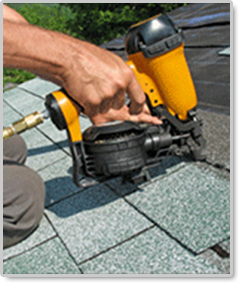Is It Time to Replace My Roof?

The actual life of your roof depends on factors such as:
-
type of materials used
-
quality of workmanship
-
local weather conditions
-
exposure to sunlight
-
shingle color
-
roof pitch angle
-
how much walking is done on your roof
-
adequacy of attic ventilation (which helps keep your roof cooler in the summer)
To determine whether your roof is ready for replacement, it requires a visual inspection. Depending on your particular home, this visual inspection may be done from a ladder, binoculars from the ground, or from a drone camera.
CATCHING THE PROBLEM SIGNS
The following are the signs that your roof may be ready to be replaced (or at least repaired):
Missing Shingles.
If your roof has begun losing shingles, then this is one of the tell-tale signs that your roof may need to be replaced. Missing one or two shingles after a severe windstorm is one thing, but missing shingles in multiple locations across your roof is a bad sign.Loss of Granules
. Asphalt shingles contain a top layer of granules, which are small particles of crushed granite that help protect the shingle from the sun's damaging ultraviolet radiation. When these granules start coming off of the shingle, it leaves the shingle vulnerable to damage. If you begin finding piles of grit from your asphalt roof accumulating in your roof gutters, this is a bad sign.Cracking, Buckling, Curling & Blistering.
If you begin to see large sections of your shingles that just don’t look right, then this is a sign that your roof maybe due for replacement. Some of these problems may be due to inadequate ventilation of your attic space. Proper ventilation of your attic is necessary to help keep your roof cooler in the summer, and to reduce moisture levels.Moss and Lichen Build-up.
Black algae stains are just cosmetic and typically will not cause deterioration of your roof. However, the building up of moss and lichen on your roof can signal that your roof has begun decaying underneath the shingles.Peeling Paint on the Underside of Roof Overhangs.
If you begin to see watermarks, spotting or peeling paint on the underside of your roof overhangs, this could be a sign that your roof has already started leaking.Ceiling Spots
. Moisture spots and dark areas on your indoor ceilings can, of course, be indications that your roof has begun to leak. They can also be a sign that the flashing around vent pipes, your chimney, etc. needs to be re-sealed. If you have an attic with exposed roof beams and boards, you can inspect to try to see where the source of the water is coming from.If you begin to notice any of these problems with your roof, you should immediately have a thorough inspection done of your roof. One of the tough questions will be whether it is better to patch a few bad areas of your roof, or if you need to do a complete roof replacement. The answer to this will be determined by the extent of your roof’s problem and its age.
Related Articles . . .
Why Would I Ever Want to go Up In My Attic???
This article describes how a trip up to your attic (by you or a professional) can help you save energy and catch problems early in your home before they turn into very expensive repairs.
Taking Care of Your Brick Siding
Brick siding can give a home a stately appearance, and for most homes, brick siding requires significantly less maintenance than wood siding. However this does NOT mean NO maintenance.
Protecting and Cleaning Your Vinyl Siding
Since vinyl siding never needs painting, it might be easy to assume that this means that your vinyl siding is indestructible and requires no maintenance. But unfortunately, this is not the case.







